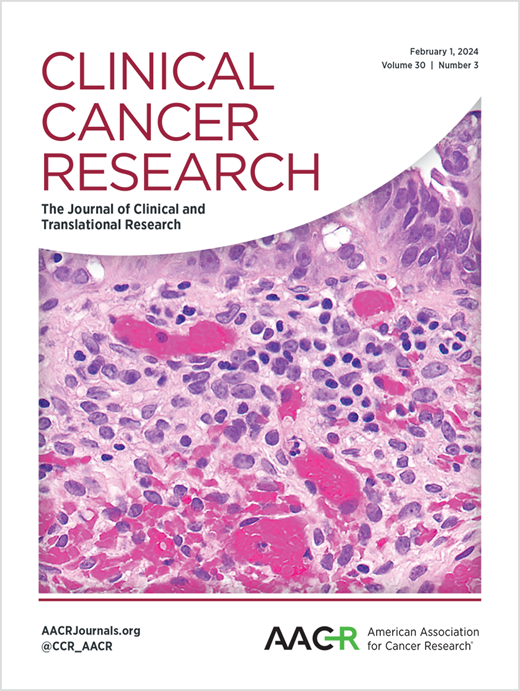olaparib, durvalumab和fulvestrant联合治疗晚期ER+/HER2-乳腺癌患者和选择的基因组改变:DOLAF试验的结果
IF 10.2
1区 医学
Q1 ONCOLOGY
引用次数: 0
摘要
目的先前的数据表明,在不同的遗传环境中,PARP抑制和免疫检查点阻断之间存在协同作用。无论基因组背景如何,雌激素受体(ER)途径仍然是转移性乳腺癌的关键靶点。本研究评估了PARP、ER和PDL1联合抑制在转移性乳腺癌患者和相关基因组改变中的活性。患者和方法在这项多中心单组II期临床试验中,我们使用Simon的两阶段设计来评估durvalumab, olaparib和fulvestrant联合作为ER+/HER2-转移性乳腺癌患者的二线或三线治疗的活性和安全性。hrr基因体细胞或种系突变、MSI状态或内分泌耐药相关突变的患者均符合条件。主要终点为24周无进展生存率(PFSR)。结果纳入的172例(100%)患者既往接受过转移性乳腺癌的内分泌治疗,86%使用CDK4/6抑制剂,67例(39%)既往有记录的gBRCA1/2m。在可评估人群中,24周PFSR为66.7% (95% CI: 58.6-74.1),在gbrca1 / 200万患者中为76.3% (95% CI: 63.4-86.4)。ITT和gBRCA1/2m人群的中位PFS分别为9.3个月(95% CI: 7.5-12.7)和12.6个月(95% CI: 8.2-16.7)。中位OS为30个月(95% CI: 26.6 nr)。最常见的不良事件是恶心(59%)和虚弱(43%)。没有发现新的毒性警告。结论:在ER+/HER2-转移性乳腺癌患者中,这种三联体组合具有活性,并且具有可接受的毒性特征(NCT04053322)。本文章由计算机程序翻译,如有差异,请以英文原文为准。
Combination of olaparib, durvalumab and fulvestrant in patients with advanced ER+/HER2- breast cancer and selected genomic alterations: results of the DOLAF trial.
PURPOSE
Previous data suggest synergy between PARP inhibition and immune checkpoint blockade in different genetic settings. The estrogen receptor (ER) pathway remains a key target in metastatic breast cancer whatever the genomic context. This study assess the activity of the combination of PARP, ER, and PDL1 inhibition among patients with metastatic breast cancer and relevant genomic alterations.
PATIENTS AND METHODS
In this multicenter single arm phase II clinical trial, we used a Simon's two-stage design to evaluate the activity and safety of a combination of durvalumab, olaparib and fulvestrant as second- or third-line in patients with ER+/HER2- metastatic breast cancer. Patients with either somatic or germline mutations of an HRR-gene, an MSI status or an endocrine resistance-related mutation were eligible. Primary endpoint was 24-week progression-free survival rate (PFSR).
RESULTS
The 172 (100%) patients included received prior endocrine therapy for metastatic breast cancer, 86% a CDK4/6 inhibitor, and 67 (39%) had a previously documented gBRCA1/2m. The 24-week PFSR was 66.7% (95% CI: 58.6-74.1) in the evaluable population and 76.3% (95% CI: 63.4-86.4) in gBRCA1/2m patients. Median PFS was 9.3 months (95% CI: 7.5-12.7) and 12.6 months (95% CI: 8.2-16.7) in the ITT and gBRCA1/2m populations, respectively. Median OS was 30 months (95% CI: 26.6-NR). Most common adverse events of any grade were nausea (59%) and asthenia (43%). No new toxicity warning was detected.
CONCLUSION
In patients with ER+/HER2- metastatic breast cancer and selected genomic alterations, this triplet combination was active and had an acceptable toxicity profile (NCT04053322).
求助全文
通过发布文献求助,成功后即可免费获取论文全文。
去求助
来源期刊

Clinical Cancer Research
医学-肿瘤学
CiteScore
20.10
自引率
1.70%
发文量
1207
审稿时长
2.1 months
期刊介绍:
Clinical Cancer Research is a journal focusing on groundbreaking research in cancer, specifically in the areas where the laboratory and the clinic intersect. Our primary interest lies in clinical trials that investigate novel treatments, accompanied by research on pharmacology, molecular alterations, and biomarkers that can predict response or resistance to these treatments. Furthermore, we prioritize laboratory and animal studies that explore new drugs and targeted agents with the potential to advance to clinical trials. We also encourage research on targetable mechanisms of cancer development, progression, and metastasis.
 求助内容:
求助内容: 应助结果提醒方式:
应助结果提醒方式:


